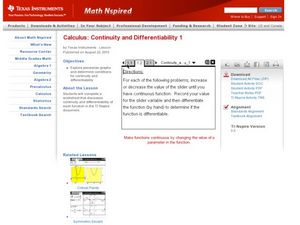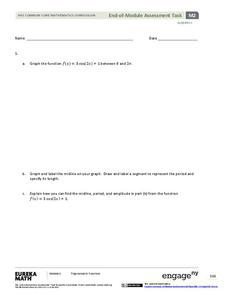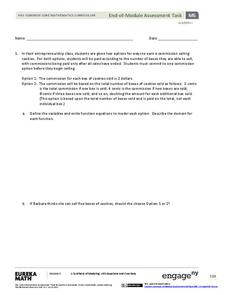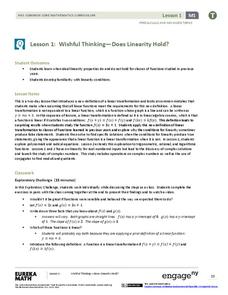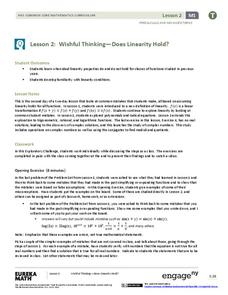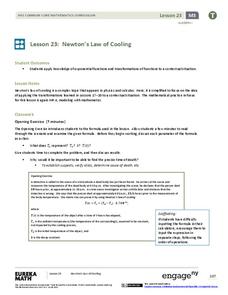Derivatives Teacher Resources
Find Derivatives lesson plans and worksheets
Showing 1,443 resources
Curated OER
Introduction to Differentiation
For this introduction to differentiation worksheet, students solve and complete 10 various types of problems. First, they use the definition of differentiation to evaluate the derivative of the functions listed. Then, students sketch the...
Curated OER
MVT for Derivatives
Young scholars find the derivative using the mean value theorem in this calculus lesson. They find the slopes of secant and tangent lines, then analyze the function and identify the slope.
Curated OER
Sign of the Derivative
Learn how to investigate the change in a graph by dragging the cursor to observe the change in the function. They use the TI calculator to graph their parabola.
Curated OER
Derivative Analysis
Students analyze the derivative of a graph. In this calculus lesson, students identify the different behavior of a graph. They label concavity of the graphs as increasing or decreasing.
Curated OER
Seeing is Believing: Derivatives
Learn to solve functions by taking the derivatives. In this calculus lesson, students compare the graph of a derivative to that of the original function.
Curated OER
Euler Encore 1
In this math worksheet, young scholars use Euler's Method to solve differential equations. They are given an equation to graph (y'). Students sketch that equation as well as the related equation (y). They find the area of given...
Curated OER
Finding the Derivative
In this calculus worksheet, 11th graders solve functions and rational expressions using the 1st and 2nd derivatives. They calculate the rate of change of an area using the derivative. There are 4 questions.
Curated OER
Higher Order Derivatives
Learn how to solve problems by taking the derivative. Then, through examination of higher order derivatives using the CAS computer program, young scholars create a visual of what is happening with the equation.
Texas Instruments
Continuity and Differentiability 1
Pupils examine graphs for continuity and differentiability in this calculus lesson. They observe piecewise functions to see where continuity and differentiability come into play. Learners finish by graphing their equation on the TI...
Curated OER
Functions and Differentiation
In this calculus worksheet, students identify functions based on different Theorems as it relates to calculus and the Fundamental Theorem. There are 13 questions dealing with differentiation and trigonometric graphs.
Curated OER
Worksheet 15
In this math worksheet, students sketch and label on a number line the regions that converge and diverge with the sequences. Then they examine a smooth function and define its series.
EngageNY
Algebra II Module 2: End-of-Module Assessment
Will this be on the test? Learners demonstrate their understanding of trigonometric functions with an end-of-module assessment. They investigate two different real-world situations, one function in pure mathematics, and one...
EngageNY
End-of-Module Assessment Task - Algebra 1 (Module 5)
This unit assessment covers the modeling process with linear, quadratic, exponential, and absolute value functions. The modeling is represented as verbal descriptions, tables, graphs, and algebraic expressions.
Rice University
Calculus Volume 1
Differentiate between calculus concepts. The beginning of a helpful calculus resource begins with a short review of functions and moves right into limits to define derivatives. The six-chapter resource continues with applications of...
Krista King Math
Equation of the Normal Line at a Point
Is it normal to find a perpendicular line to the tangent line? The short video provides a problem to find the equation of the normal line to a function. Beginning with an explanation of the normal line, the 27th installment in a 31-part...
EngageNY
Choosing a Model
There's a function for that! Scholars examine real-world situations to determine which type of function would best model the data in the 23rd installment of a 35-part module. It involves considering the nature of the data in addition to...
EngageNY
Analyzing a Verbal Description
What function will describe the insect population growth? Pairs or small groups work together to determine which type of function and specific function will model given scenarios. The scenarios differentiate between linear,...
EngageNY
Tides, Sound Waves, and Stock Markets
Help pupils see the world through the eyes of a mathematician. As they examine tide patterns, sound waves, and stock market patterns using trigonometric functions, learners create scatter plots and write best-fit functions.
EngageNY
Wishful Thinking—Does Linearity Hold? (Part 1)
Not all linear functions are linear transformations — show your class the difference. The first lesson in a unit on linear transformations and complex numbers that spans 32 segments introduces the concept of linear transformations and...
EngageNY
Analyzing a Data Set
Through discussions and journaling, classmates determine methods to associate types of functions with data presented in a table. Small groups then work with examples and exercises to refine their methods and find functions that work...
Educator.com
Newton's Method and Inflection Point
The inflection point, the point where the second derivative is zero, is the focus of a video that works through a problem where it is not obvious to see the roots of a function. The solution to the problem requires using...
EngageNY
Wishful Thinking—Does Linearity Hold? (Part 2)
Trying to find a linear transformation is like finding a needle in a haystack. The second lesson in the series of 32 continues to explore the concept of linearity started in the first lesson. The class explores trigonometric, rational,...
EngageNY
Integer Sequences—Should You Believe in Patterns?
Help your class discover possible patterns in a sequence of numbers and then write an equation with a instructional activity that covers sequence notation and function notation. Graphs are used to represent the number patterns.
EngageNY
Newton’s Law of Cooling
As part of an investigation of transformations of exponential functions, class members use Newton's Law of Cooling as an exponential model to determine temperature based on varying aspects. The resource makes comparisons between...










